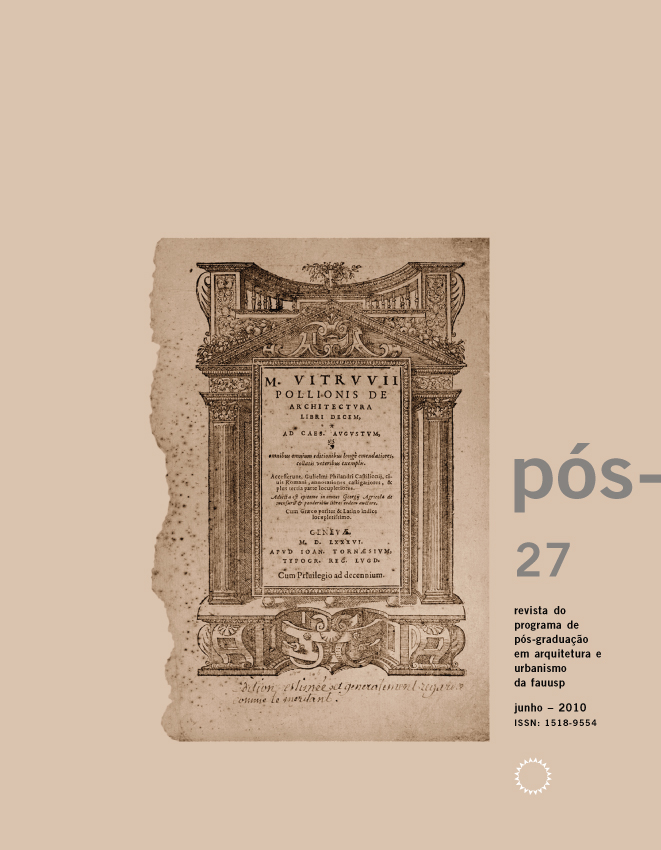The South as a witness: the decline of the corbusian-carioca hegemony and the rise of the dissidence from São Paulo in Brazilian architecture in the 1950s
DOI:
https://doi.org/10.11606/issn.2317-2762.v0i27p46-65Keywords:
Modern architecture in Brazil, modern architecture in São Paulo, international style, Legislative Palace of Rio Grande do SulAbstract
This paper illustrates a variant of brazilian architecture that has mistakenly been called "international style." International style was first adopted in São Paulo as the result of converging influences, including Mies van der Rohe, Marcel Breuer, the Case Study House Program, and Concretism. It defined an alternative to the then prevailing corbusian-carioca model. Its constructive tone sought features like synthesis, rationalism, atemporality, and, consequently, universality, moving away from both the corbusian matrix and the autochthonous features, which together had been responsible for the corbusian model's wide success. The influence of this alternative trend in modern architecture spread to other brazilian regions, including the city of Porto Alegre, where it was part of the winning bid for the Legislative Palace of the Rio Grande do Sul State (1958), designed by two architects from São Paulo. This project marked an important change in that state's architectural production, and helped create a turning point for Brazil, after which the overwhelming carioca school had to make room for dissident architectural style.Downloads
References
AMARAL, Aracy. Arte para quê? São Paulo: Studio Nobel, 2003.
BARROS, Regina Teixeira de. Antônio Maluf – Arte concreta paulista. São Paulo: CosacNaify, 2002.
BRITO, Ronaldo. Neoconcretismo – Vértice e ruptura do projeto construtivo brasileiro. São Paulo: CosacNaify, 1999.
CARTER, Peter. Mies van der Rohe. An appreciation on the occasion, this month, of his 75th birthday. Revista Architectural Design, Londres, 1961.
CINTRÃO, Rejane; NASCIMENTO, Ana Paula. Grupo Ruptura: Revisitando a exposição inaugural – Arte concreta paulista. São Paulo: CosacNaify, 2002.
FAUSTO, Boris. História concisa do Brasil. São Paulo: Edusp/Imprensa Oficial do Estado, 2002.
FERRAZ, Geraldo. Ludwig Mies van der Rohe. Revista Habitat, São Paulo, n. 56, 1959.
GALEAZZI, Ítalo. Mies van der Rohe no Brasil. Projeto para o Consulado dos Estados Unidos em São Paulo, 1957-1962. Arquitextos, São Paulo, n. 56, 2005. Disponível em: http://www.vitruvius.com.br/ arquitextos/arq056/arq056_03.asp.
KIEFER, Flávio; MAGLIA, Viviane Villas Boas. Refinaria Alberto Pasqualini – Entrevista com os autores. Cadernos de Arquitetura Ritter dos Reis, Porto Alegre, n. 2, 2000.
LUCCAS, Luís Henrique Haas. A escola carioca e a arquitetura moderna em Porto Alegre. Arquitextos, São Paulo, n. 73, 2006. Dspon[ivel em: http://www.vitruvius.com.br/arquitextos/arq000/esp370.asp. Texto especial, n. 370.
LUCCAS, Luís Henrique Haas. Arquitetura moderna e brasileira: O constructo de Lucio Costa como sustentação. Arquitextos, São Paulo, n. 63, 2005. Disponível em: http://www.vitruvius.com.br/ arquitextos/arq000/esp323.asp. Texto especial, n. 323.
LUCCAS, Luís Henrique Haas. Arquitetura moderna brasileira em Porto Alegre: Sob o mito do “gênio artístico nacional”. 2004. Tese (Doutorado em Arquitetura) – PROPAR-UFRGS, Porto Alegre, 2004.
MACCOY, Esther. Case study houses, 1945-1962. Santa Mônica: Hennesey+Ingalls, 1977.
MARTINS, Lineu. Muito edifício, pouca arquitetura. Revista do Globo, Rio Grande do Sul, n. 711, 1958.
SAIA, Luís. Ludwig Mies van der Rohe. Revista Habitat, São Paulo, n. 22, 1955.
SEGAWA, Hugo. Oswaldo Arthur Bratke. São Paulo: ProEditores Associados, 1997.
XAVIER, Alberto et al. Arquitetura moderna paulistana. São Paulo: Pini, 1983.
ZANINI, Walter. História geral da arte no Brasil. São Paulo: Instituto Moreira Salles, 1983.
Downloads
Published
Issue
Section
License

This work is licensed under a Creative Commons Attribution 4.0 International License.
DIADORIM - Diretório de Políticas Editoriais












